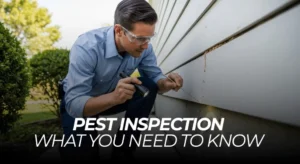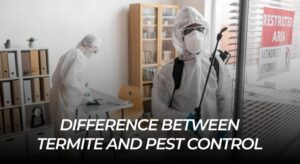Many owners would think that pest control and termite control would be the same service. They’re not. Both of them safeguard your house in the face of the invaders, but they defend against different threats and with different methods.
Knowing the difference between termite and pest control can save you thousands of property damage. It also assists you in getting the appropriate protection for your special requirements. It is most important because you do not run the risk of leaving your home exposed to silent killers.
What Is Pest Control?
Pest control focuses on a broad spectrum of insects and animals that infiltrate homes. The common targets are ants, cockroaches, spiders, miceand rats, and wasps. These services are oriented towards the removal of the existing infestations and the prevention of future issues.
The common rates of pest control application are monthly and quarterly among the companies. They utilize the spraying, baits, and traps to control different pests. This is done to create an obstruction around your house that will keep intruders, unwanted creatures out.
What Is Termite Control?
Termite control specializes in only the control and prevention of termites. These are the services that need specialized knowledge about the behavior and the biology of termites. The technicians should be familiar with the various termite species and their various feeding habits.
Treatment against termites is usually more rigorous than normal pest control. They are commonly borne of soil treatments, wood treatments, or bait systems. It is geared towards long-term security instead of short-term solutions.
Related Article: How to Keep Your Home Pest-Free All Year Round
Key Differences in Treatment Methods
Pest control comprises disease precautions and general surface treatment. The technicians spray around the points of entry, place baits where there is suspected activity, and seal up apparent openings. These are treatment options that deal with pests you can normally observe
Termite Control is much more; literally speaking, treatment can take the form of drilling into concrete, injecting chemicals into soil, and installing monitoring stations. The work can tackle pests that may take years before being detected.
Cost Differences Between Services
The average cost of a general pest treatment is between 100-300 dollars. Annual subscriptions may cost between 400 dollars and 1200 dollars, depending on the area you reside in. These services come with predictable, manageable costs.
Termite control also imposes more expenditure at the start, with prolonged protection over time. First treatments may cost between 1,200 and 3,000 or more. These procedures can last about 5 to 10 years in the case of satisfactory maintenance.
Inspection Requirements
The inspections involved during pest control are only on the surface and the frequently inspected areas. Technicians inspect droppings, nests, and points of entry. Such inspections tend to last between 30 and 60 minutes.
Termite inspections involve a lot more thorough scrutiny. Crawl spaces, structural elements, and basements are inspected by professionals. They have specialized equipment that locates concealed damage and moisture.
Treatment Frequency
The majority of pest control companies operate on regular rotational patterns. Treatments are regularly practiced every month where there is an active infestation. Maintenance visits every quarter are effective preventively.
Termite Treatments have a completely different timeline. The early treatments offer several years of safety. Annual reviews will facilitate the checking of the effectiveness of the system and will detect any new activity at an early stage.
Professional Training and Licensing
Pest control practitioners are generalists who are trained in various pest species. They are taught about the different insects, rodents, and ways to treat them. Licensing regulation differs by state, but encompasses the wide principles of pest management regulation
Termite exterminators receive comprehensive training that focuses on termites. They examine the effects of wood-destroying insects, the chemical properties of the soil, and the weak spots in structures. Some possess special certification over and above the common pest control-based licenses.
When to Choose Pest Control
General pest control is preferable when visible pests such as ants or cockroaches are involved. The service is best suited to continuing maintenance and annual issues. It is also the correct option whenever one has a variety of pests that come along.
Pest control is logical in apartments and rentals, where structural treatment is not feasible. The monthly or quarterly services offer reasonable protection against most typical household pests.
When to Choose Termite Control
If you have noticed signs of termite activity, it is important to select termite control. A wood rot, mud tube, or swarming insect is an indication that special treatment is necessary. Wait no more, termites destroy billions of dollars a year.
This is a saving that is necessary in purchasing and selling houses in order to deal with termites. Termite inspections and clearances are mandatory at most mortgage companies. Preventive measures are the best ways to guard your investment before it is worn out.
Signs You Need Termite Control
Inspect the walls of your foundation or the walls of your home. These are tunnels that are just like a pencil used to access a source of soil and wood. Termites construct it as a defense mechanism when they are on the move.
Listen to walls or floors to make sure there is no hollow-sounding wood. Termites chew out wood by biting the inside, leaving very little outer bits. The wobbling floors or the inability of the doors to latch can indicate damage to the structure.
Signs You Need General Pest Control
The frequent appearance of pests is a good sign that professional assistance is required. A normal amount of seeing ants, cockroaches, or spiders indicates that DIY solutions are failing. It is not necessary to postpone solving small problems until they have acquired the status of mass outbreaks.
Strange odors, periodic sounds, or dropping of pests are also indicators of problems. All these indicators indicate a pre-existing population, and they all need intervention by a professional.
Making the Right Choice for Your Home
When selecting services, take into account the age, location, and construction material of your home. The more aged houses usually require pest protection as well as termite protection. Newer houses can have pest management as the beginning and add termite repellency to it afterwards.
Also assess heat stress and pest loads in your area. In certain parts, there is increased activity of termites that requires special consideration. Some are subject only to seasonal pest outbreaks that are successfully combated using general controls.
Finding the Right Professional
Contact research companies that specialize in your specific needs. Read reviews and confirm licensing with the regulator in your state. Request a more elaborate treatment schedule and warranties.
You should get several quotes so you can compare the companies, but you cannot decide which one to use based on price alone. Terms such as experience, reputation, and guarantee are more important than initial costs. The low-cost alternative usually proves the most costly error in judgment.
Your Next Steps
Evaluate your present pest situation realistically. Record any evidence of pest indication with pictures and dates. This knowledge assists practitioners in formulating effective treatment strategies.
Seek regular inspection with qualified individuals who can assess your needs in particular. Do not suppose that there is a single service that can take care of all the needs of your house. The correct protection program will ensure that you keep your house safe as well as ensure that your family is comfortable in the years to come.







